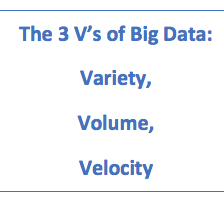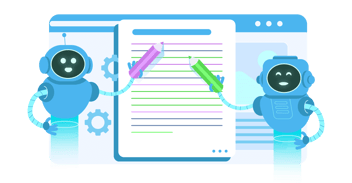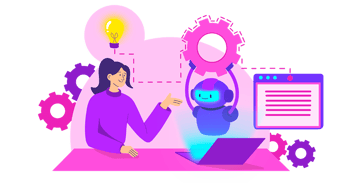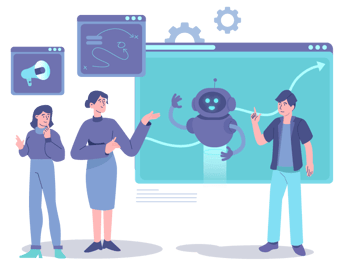Intelligenza artificiale, un glossario dei termini
L'intelligenza artificiale (AI) si sta insinuando da tempo nelle tecnologie di marketing. È probabile che utilizziate diversi strumenti di marketing che si basano almeno in parte sull'intelligenza artificiale, anche se non lo sapete. Poiché queste tecnologie sono sempre più diffuse, è importante capire cosa sono e come influiscono sul futuro del settore. Ecco una panoramica di alcuni termini chiave legati all'IA e di come l 'Intelligenza Artificiale cambia il marketing.
 Algoritmo
Algoritmo
In poche parole, un algoritmo è un insieme di istruzioni matematiche. Ogni algoritmo agisce come istruzioni passo-passo per un programma informatico. Se un tempo gli algoritmi dovevano essere programmati esplicitamente, oggi alcuni algoritmi sono progettati per consentire ai computer di apprendere in modo autonomo (si veda la definizione di apprendimento automatico di seguito). Gli algoritmi sono già presenti nella nostra vita quotidiana. Per esempio, determinano i contenuti che vediamo su Facebook, Netflix, Amazon e Google. Gli esperti stimano che un algoritmo suggerisca il 75% di ciò che guardiamo su Netflix.
Gli esperti di marketing hanno già messo in pratica gli algoritmi in una miriade di modi, perché gli algoritmi possono mettere insieme dati provenienti da varie fonti per prevedere e influenzare il comportamento dei consumatori. L'applicazione degli algoritmi porterà anche una nuova responsabilità alle iniziative di marketing e media, in quanto i marketer avranno sempre più la possibilità di collegare i loro sforzi agli obiettivi aziendali.
Automazione
L'International Society of Automation (ISA) definisce l'automazione come "la creazione e l'applicazione della tecnologia per monitorare e controllare la produzione e la consegna di prodotti e servizi". L'introduzione dell'automazione nel marketing ha rivoluzionato il settore, consentendo ai professionisti di dedicare il loro tempo ad attività significative e a valore aggiunto invece che a compiti ripetitivi.
Ma anche l'approccio "imposta e dimentica" dell'automazione convenzionale è ancora piuttosto intensivo dal punto di vista manuale. Un uomo deve impostare il processo da automatizzare e anche le modifiche a tale processo devono essere definite, avviate ed eseguite da un uomo. Il futuro dell'automazione sarà alimentato dall'intelligenza artificiale, che eliminerà la necessità di un'ulteriore supervisione umana (si veda la definizione di automazione intelligente di seguito).
Big Data
Nel 2001 Gartner ha definito i Big Data come "dati che contengono una maggiore varietà, che arrivano in volumi crescenti e con una velocità sempre maggiore". Questa definizione delle "tre V" è ancora la più diffusa e accettata. Negli anni successivi, i marketer si sono trovati di fronte a una mole di dati sempre più ampia e proveniente da fonti sempre più diverse; il 90% di tutti i dati del mondo è stato creato negli ultimi due anni e il volume continua ad aumentare a velocità sempre maggiore.

In effetti, i Big Data hanno costretto i responsabili marketing a ripensare a come assimilare in modo significativo informazioni apparentemente infinite. Nei prossimi anni, i team di marketing probabilmente collaboreranno più strettamente con i team IT per implementare le tecnologie necessarie a gestire grandi quantità di dati. Dovranno anche fare delle scelte su quali dati contribuiscono veramente a migliorare le conoscenze.
I bot
I bot hanno avuto una brutta fama. I marketer non etici usano i bot per gonfiare il traffico di un sito web imitando le visualizzazioni delle pagine o i clic sugli annunci. Ma i bot hanno un grande potere positivo per i professionisti del marketing. Un bot è semplicemente un'applicazione software che esegue attività automatizzate via Internet. I chatbot sono comparsi sui siti web di tutto il mondo e si sono rivelati un modo eccellente per coinvolgere i clienti. Ma è possibile utilizzare i bot anche per condurre ricerche, seguire progetti e persino vendere prodotti in modo autonomo.
I bot stanno diventando sempre più sofisticati grazie all'intelligenza artificiale. Ad esempio, l'implementazione di un chatbot AI in grado di effettuare conversazioni sempre più naturali darà alle organizzazioni la possibilità di coinvolgere un maggior numero di visitatori del sito web e di raccogliere ancora più informazioni su questi ultimi prima che un umano intervenga nella conversazione.
Apprendimento profondo
L'apprendimento profondo è una tecnica di apprendimento automatico che si basa su una rete neurale per aiutare un computer a imparare con l'esempio, proprio come farebbe un essere umano. La tecnologia dell'apprendimento profondo è alla base delle auto senza conducente e dei dispositivi di consumo a controllo vocale. Gli "esempi" necessari per l'apprendimento profondo sono insiemi di dati etichettati incredibilmente grandi, che il computer utilizza per imparare classificazioni pertinenti.
Le prestazioni dei dispositivi di deep learning possono superare quelle degli esseri umani. Nel mondo del marketing, il deep learning probabilmente rivoluzionerà il nostro approccio alla SEO, poiché le macchine diventeranno sempre più brave a prevedere gli algoritmi di classificazione.
Automazione intelligente (IA)
L'automazione intelligente (IA) è il risultato della combinazione dell'automazione con l'intelligenza artificiale, che porta alla raccolta automatica dei dati, all'analisi e al processo decisionale. Ad esempio, supponiamo che qualcuno compili il modulo di contatto sul vostro sito web e includa una breve nota o un commento.
L'automazione da sola consente al team di marketing di notificare alle persone giuste l'invio del modulo e di inviare subito un autoresponder. Ma se a questa capacità si aggiunge l'intelligenza artificiale, il software è in grado di "leggere" la nota per decidere quanto sia urgente e chi debba seguirla. In alcuni casi, grazie all'elaborazione del linguaggio naturale (definita di seguito), il software potrebbe persino essere in grado di rispondere in modo appropriato.
Grazie all'IA, la personalizzazione non significherà solo includere il nome di battesimo dei destinatari delle e-mail nell'oggetto o nel saluto. Sarete in grado di essere molto più granulari. Immaginate di inviare un'e-mail a ciascun contatto nel momento ideale in base ai suoi comportamenti precedenti. Oppure pensate di inviare automaticamente l'offerta giusta in base alla cronologia delle ricerche recenti di una persona.
Tendiamo a pensare all'intelligenza artificiale (AI) come a tecnologie tangibili, come i robot o addirittura Watson. Ma la maggior parte della tecnologia alimentata dall'AI esiste in una forma molto più astratta, sotto forma di algoritmi. E questa tecnologia è essenziale per i marketer che vogliono rimanere all'avanguardia nel settore.
Internet degli oggetti (IoT)
L'Internet delle cose (IoT) si riferisce alla connessione dei dispositivi di uso quotidiano a Internet. Ha già avuto un impatto significativo sulla catena di approvvigionamento globale perché consente a macchine e altri dispositivi di "parlare" tra loro. Per i marketer, l'IoT promette di fornire un contesto molto più ampio per le abitudini, le esigenze, i desideri, l'utilizzo dei prodotti e l'intenzione di acquisto dei clienti.
Secondo IoT Analytics, quest'anno i dispositivi IoT hanno superato i 7 miliardi. Si tratta di una manna per i marketer, che possono ottenere una visione incredibile dei loro clienti in ogni fase del percorso dell'acquirente. Ma presenta anche una sfida significativa: tutti questi dispositivi connessi producono già montagne e montagne di dati. Con l'aumento del numero di dispositivi, aumenterà anche la quantità di dati. I marketer più accorti ricorreranno alla tecnologia AI per vagliare tutto e trarre conclusioni significative.
Apprendimento automatico
In passato, i robot e i computer potevano automatizzare le attività che rientravano in una serie di regole specifiche. Il dispositivo veniva programmato per operare secondo le regole, niente di più e niente di meno. Ma l'apprendimento automatico è esattamente ciò che sembra: le macchine sono in grado di imparare dai dati che analizzano, facendo previsioni e pronostici sulla base di un numero di dati molto più elevato di quello che gli esseri umani potrebbero fare da soli. Ad esempio, mentre gli esseri umani possono analizzare i dati da una sola fonte, spiega il sito web, l'apprendimento automatico significa che è possibile ricavare informazioni dagli schemi di utilizzo del sito web, dei social media, delle e-mail e dei social media, oltre che dalle risposte dei clienti alle campagne precedenti.
L'apprendimento automatico ha molteplici applicazioni promettenti per i marketer. È la tecnologia ideale per una sofisticata segmentazione dei clienti, che consente di identificare piccoli gruppi di clienti che condividono preferenze e tendono ad avere modelli di comportamento simili. L'apprendimento automatico è anche in grado di predire il tasso di abbandono dei clienti, consentendo agli addetti al marketing di raggiungere in modo proattivo i clienti ad alto rischio e di diminuire le probabilità di abbandono.
Elaborazione del linguaggio naturale
Un tempo le macchine erano in grado di comprendere solo il codice. Ma le cose sono cambiate grazie all'elaborazione del linguaggio naturale (NLP), che si riferisce alla capacità di una macchina di comprendere il linguaggio umano attraverso l'apprendimento automatico e l'intelligenza artificiale. L'NLP si è evoluto negli ultimi anni e, in alcuni casi, questa tecnologia è in grado di comprendere le emozioni o le connotazioni del linguaggio umano. L'NLP è spesso abbinato alla generazione del linguaggio naturale (NLG), in cui la macchina elabora il linguaggio umano e genera una risposta in lingua umana; i sistemi di riconoscimento vocale come Alexa di Amazon e Siri di Apple funzionano in questo modo.
Molti addetti al marketing si affidano già a qualche forma di NLP per l'analisi del sentiment. Ma è promettente anche per la personalizzazione. La maggior parte delle organizzazioni si rivolge a un pubblico geograficamente, e quindi linguisticamente, diverso. Queste differenze linguistiche possono essere sottili (come le variazioni regionali dell'inglese americano), più evidenti (come le differenze tra l'inglese americano e l'inglese della Regina), o addirittura coinvolgere lingue diverse. La PNL può aiutarvi a personalizzare le comunicazioni in base a queste differenze, in modo da trasmettere messaggi che abbiano maggiori probabilità di coinvolgere ciascun destinatario.
Rete neurale
Una rete neurale è essenzialmente progettata per imitare il cervello umano. La rete è composta da una serie di livelli. Ogni strato comprende molti nodi, o singole unità di elaborazione, collegati agli altri nodi dello stesso strato e ai nodi degli strati superiori e inferiori. Lo strato più basso della rete riceve i dati e li trasmette a quello successivo. Sebbene lo scopo di una rete neurale sia quello di simulare un cervello, la rete non funzionerà esattamente come una mente umana. Le reti neurali sono utilizzate soprattutto per il riconoscimento di modelli, le previsioni, la previsione di tendenze e persino la generalizzazione.
Microsoft ha utilizzato BrainMaker, un software di rete neurale, per ottimizzare le sue campagne di direct mailing, identificando le variabili più critiche per il successo delle campagne di direct mailing, in modo da ottimizzare le campagne future. Secondo un portavoce dell'azienda, l'uso di BrainMaker ha aumentato il tasso di risposta da circa il 4,9% all'8,2%, un miglioramento considerevole. L'uso delle reti neurali per l'ottimizzazione delle campagne è molto promettente per gli esperti di marketing.
Analisi predittiva
Una branca dell'analitica avanzata, l'analitica predittiva, viene utilizzata per prevedere eventi futuri utilizzando tecniche di data mining, modellazione statistica e apprendimento automatico. Per massimizzare i vantaggi dell'analisi predittiva, è necessario partire da un'ampia serie di dati storici. La raccolta rigorosa di dati nel marketing è relativamente recente - si pensi a come è cambiato il ruolo dell'analitica solo nell'ultimo decennio - e quindi l'analitica predittiva è emersa come tecnologia ampiamente applicabile solo negli ultimi anni.
Amazon e altri rivenditori online utilizzano ampiamente l'analisi predittiva per modellare il probabile comportamento dei clienti. Può essere utilizzata anche per il lead scoring predittivo, in modo che i team di marketing e vendita possano adattare le campagne e le offerte ai lead e ai clienti con maggiori probabilità di conversione. Nel frattempo, l'applicazione dell'analisi predittiva ai dati relativi ai vostri clienti esistenti di alto valore può aiutarvi a sviluppare strategie per raggiungere un maggior numero di nuovi clienti come loro.
Avete domande su come l'intelligenza artificiale può dare una spinta al vostro marketing?
Questo contenuto è disponibile in:
- Tedesco: KI verstehen: Wie künstliche Intelligenz das Marketing revolutioniert
- Inglese: Artificial Intelligence, a Glossary of Terms
- Spagnolo: Glosario de términos de inteligencia artificial
- Francese: Intelligence artificielle, un glossaire
- Rumeno: Inteligența artificială, un glosar de termeni
- Cinese: 人工智能术语表








Facci sapere cosa ne pensi.